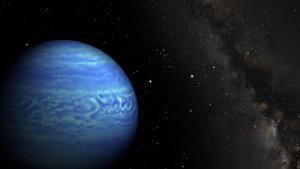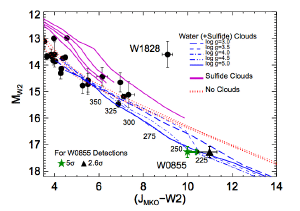Blog
Cloudy With a
Chance of Star
27 August 2014
 NASA, JPL-Caltech and Penn State University
NASA, JPL-Caltech and Penn State UniversityWISE J0855-0714 (also known as W0855) is a brown dwarf about 7 light years from us. Based upon its temperature, it is estimated to have a mass of about 10 Jupiters. The minimum mass to be considered a star is usually taken as 13 Jupiter masses, so this particular brown dwarf is either a very, very small star or (more likely) a very large Jupiter-type planet. That makes it either the 4th most distant star system or the closest known rogue planet. What we know for sure is that it is the coldest known brown dwarf, with a surface temperature of about 260 K (or 25 degrees below freezing for us Americans). It may also have a rather interesting atmosphere.
 Faherty et al
Faherty et alA new paper in Astronomy and Astrophysics Letters has announced the presence of clouds on the brown dwarf.1 The team made near-infrared observations of W0855, and compared them with various models of cold brown dwarfs. They found the best agreement was of an atmosphere with partial water clouds. This is unusual, since most known worlds are either cloudless (Mars) or shrouded in clouds (Venus, Titan). Of course W0855 is much more Jupiter-like, being about the same size, but with more mass. What such a partly-cloudy Jovian planet might look like is still unclear.
It’s important to note that this result is still somewhat tentative. The planet had not been imaged in detail, and a direct spectral analysis of W0855 hasn’t been made. This is not a direct detection of water on an exoplanet, but rather agreement with a model. But what this work does show is that Jupiter-like planets are likely much more diverse than seen in our own solar system, and some may indeed have partly-cloudy skies.
Faherty, Jacqueline K., et al. “Indications of water clouds in the coldest known brown dwarf.” The Astrophysical Journal Letters 793.1 (2014): L16. ↩︎